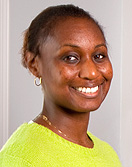News
Computer system identifies liars
-
 Print
Print -
 Comments
Comments
-

“What we wanted to understand was whether there are signal changes emitted by people when they are lying, and can machines detect them? The answer was yes, and yes.”
Inspired by the work of psychologists who study the human face for clues that someone is telling a high-stakes lie, UB computer scientists are exploring whether machines also can read the visual cues that give away deceit.
Results so far are promising: In a study of 40 videotaped conversations, an automated system the researchers developed correctly identified whether interview subjects were lying or telling the truth 82.5 percent of the time.
That’s a better accuracy rate than expert human interrogators typically achieve in lie-detection judgment experiments, says Ifeoma Nwogu, a researcher at UB’s Center for Unified Biometrics and Sensors (CUBS). In published results, even experienced interrogators average closer to 65 percent, Nwogu says.
“What we wanted to understand was whether there are signal changes emitted by people when they are lying, and can machines detect them? The answer was yes, and yes,” says Nwogu.
Her colleagues on the study included CUBS scientists Nisha Bhaskaran and Venu Govindaraju, and Mark G. Frank, a UB professor of communication and behavioral scientist whose primary area of research has been on facial expressions and deception.
In the past, Frank’s attempts to automate deceit detection have used systems that analyze changes in body heat or examine a slew of involuntary facial expressions.
The automated UB system tracks a different trait—eye movement. The system employs a statistical technique to model how people moved their eyes in two distinct situations: during regular conversation and while fielding a question designed to prompt a lie.
People whose pattern of eye movements changed between the first and second scenario were assumed to be lying, while those who maintained consistent eye movement were assumed to be telling the truth. In other words, when the critical question was asked, a strong deviation from normal eye-movement patterns suggested a lie.
Previous experiments in which human judges coded facial movements found documentable differences in eye contact at times when subjects told a high-stakes lie. Nwogu and the other computer scientists created an automated system that could verify and improve upon information used by human coders to successfully classify liars and truth tellers.
The research team presented its results at last year’s IEEE International Conference on Automatic Face and Gesture Recognition.
Though the study’s sample size was small, the findings are exciting, Nwogu says, suggesting that computers may be able to learn enough about a person’s behavior in a short time to perform a task that challenges even experienced investigators. The study included people with various skin colors, head poses, lighting and obstructions such as glasses.
The 40 videos that Nwogu and her colleagues used for the study were culled from a set of 132 that Frank recorded during a previous experiment.
In Frank’s original study, 132 interview subjects were given the option to “steal” a check made out to a political party or cause they strongly opposed.
Subjects who took the check but lied about it successfully to a retired law enforcement interrogator received rewards for themselves and a group they supported; subjects caught lying incurred a penalty: they and their group received no money, but the group they despised did. Subjects who did not steal the check faced similar punishment if judged lying, but received a smaller sum for being judged truthful.
The interrogators opened each interview by posing basic, everyday questions. Following this mundane conversation, the interrogators asked about the check. At this critical point, the monetary rewards and penalties increased the stakes of lying, creating an incentive to deceive and do it well.
In their study on automated deceit detection, Nwogu and her colleagues selected 40 interrogations and used the mundane beginning of each interview to establish what normal, baseline eye movement looked like for each subject. The team focused, in particular, on the rate of blinking and the frequency with which people shifted their direction of gaze.
The scientists then used their automated system to compare each subject’s baseline eye movements with eye movements during the critical section of each interrogation: the point in time at which interrogators stopped asking everyday questions and began inquiring about the check.
If the machine detected unusual variations from baseline eye movements at this time, the researchers assumed the subject was lying.
Nwogu says the next step in the research will be to expand the number of subjects studied and to develop automated systems using more advanced pattern-recognition models to identify liars.
She emphasizes that while automated deceit-detection systems could find use in such fields as law enforcement and security screenings, the technology is not foolproof—a very small percentage of the subjects in the study were excellent liars, maintaining their usual eye-movement patterns as they lied. Also, the nature of an interrogation and interrogators’ expertise can influence the effectiveness of the lie-detection method.

Reader Comments